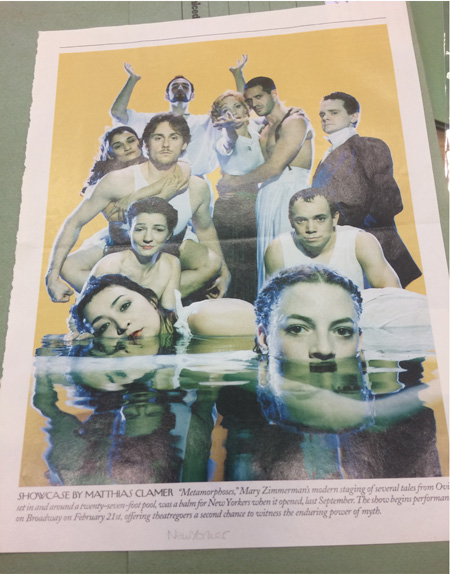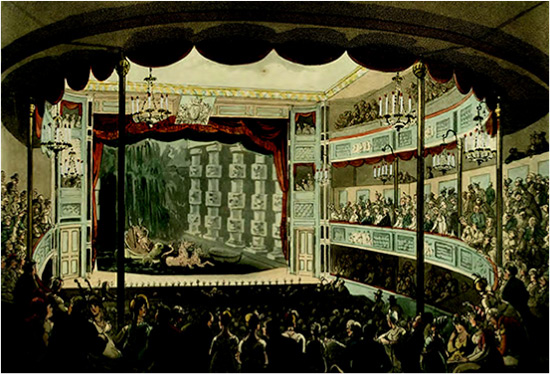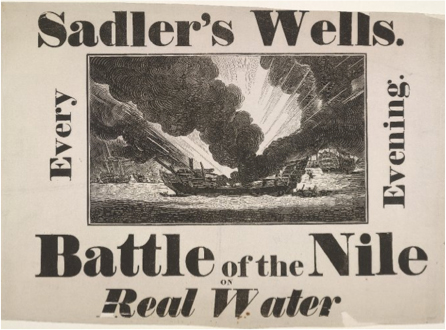The Archive in 100 Objects
 In this post, APGRD Archivist-Assistant Zoë Jennings explores the resonances of water in Mary Zimmerman's Metamorphoses (2001-2002) and Ovid's epic poem of the same name, as encapsulated in a publicity shot for the New Yorker.
In this post, APGRD Archivist-Assistant Zoë Jennings explores the resonances of water in Mary Zimmerman's Metamorphoses (2001-2002) and Ovid's epic poem of the same name, as encapsulated in a publicity shot for the New Yorker.
 Mary Zimmerman’s Metamorphoses (2001-2002) was staged exactly as our image suggests: in, on, and around a pool of water. On more than one level, staging Ovid’s Metamorphoses in water is entirely fitting. Water is the ultimate elemental metaphor for the fluidity of Ovidian metamorphosis: as playwright and director Zimmerman acknowledged during my interview with her in March 2019, Ovid’s myths have everything to do with water, because water has everything to do with change. Her critically-acclaimed Metamorphoses (originally entitled Six Myths at Northwestern University, 1996, then Metamorphoses in New York, 2001-2002), staged around a 2000-litre heated pool, is one of the most cited recent adaptations of Ovid precisely for its idiosyncratic yet deeply appropriate set.
Mary Zimmerman’s Metamorphoses (2001-2002) was staged exactly as our image suggests: in, on, and around a pool of water. On more than one level, staging Ovid’s Metamorphoses in water is entirely fitting. Water is the ultimate elemental metaphor for the fluidity of Ovidian metamorphosis: as playwright and director Zimmerman acknowledged during my interview with her in March 2019, Ovid’s myths have everything to do with water, because water has everything to do with change. Her critically-acclaimed Metamorphoses (originally entitled Six Myths at Northwestern University, 1996, then Metamorphoses in New York, 2001-2002), staged around a 2000-litre heated pool, is one of the most cited recent adaptations of Ovid precisely for its idiosyncratic yet deeply appropriate set.
Less explored is the nexus linking water, metamorphosis, and performance in Ovid’s poetry that Zimmerman also, in her own way, intuited. Water, most frequently in the form of small pastoral pools, is a recurrent and versatile feature of many of Ovid’s stories, and the poet taps into its metamorphic qualities on several occasions. Most pertinent here are the examples of ‘watery’ changes that intersect with the transformational mimetic action of performers – specifically, here, by ancient pantomime dancers (or pantomimi, though the ancient choreographic craft was entirely distinct from its modern namesake). Zimmerman’s stress on the fluidity and sensuality of her actors’ movements, which served as the perfect complement to her set, signals that she and Ovid shared a perspective on acting as an inherently metamorphic process.
Ovid’s poem is replete with allusions to the ancient art of pantomime, for which the theme of metamorphosis is indeed tailor-made, and water crops up more than once as a core element. The most explicit example is his description of Proteus, a shape-shifting sea-deity whose name, in later accounts of dance, becomes almost metonymic of the virtuoso pantomime dancer. Ovid positions his readers as spectators of Proteus’ potential transformations, ending on a flourish showcasing his ability to turn into water: ‘you might be seen… imitating the appearance of flowing water – a river’ (8.731-8).
The water-nymph Cyane is similarly located as object of the reader’s gaze before Ovid details her slow and visceral transformation into water with multiple ‘melting’ verbs: she ‘melted away into waters’, and ‘you could see her limbs softening, her bones bending’, and she literally ‘liquifies’ (5.427-37). In these examples, water is an obvious medium for conveying the corporeal ‘liquidity’ effected by dancers, as well as their ability to mould their bodies to imitate different characters or shapes.
Another angle on the watery qualities of performance can be found in the story of Narcissus, whose reflection in a pool ‘mimes’ his performance of self-love. Water, again, mediates the movements of the performer, this time not through verbs of melting or moulding but through mirrored verbs of imitation (‘he desires… he is desired’; ‘he admires… he is admired’; ‘he seeks… he is sought’; 3.424-5). What makes these examples so specifically ‘Ovidian’ is not just their focus on metamorphosis, but their meta-poetic interest in the ways metamorphosis can be portrayed through the arts. Zimmerman’s pool certainly takes up Ovid’s invitation to experiment with the aesthetic potential of the figure of physical change.
There is, however, another interpretative lens for exploring the pool’s suitability for a stage adaptation of Ovid, less to do with the art forms embraced within his poem than with the form of the poem itself. When I asked her ‘why water?’, Zimmerman’s explanation – that she had originally intended to set her adaptation of Homer’s epic Odyssey (1990) around an on-stage ocean, but it never came to fruition – opens up a new perspective on the relationship between set design and epic. Bodies of water and their associated scale (spatial and temporal) are a hallmark of many epic poems: think not just of the years-long ocean voyages in the Odyssey, Apollonius’ Argonautica, and Virgil’s Aeneid, but also of motifs of destructive flooding in Gilgamesh, the Iliad, and Ovid’s Metamorphoses, as well as shipwrecks and naval battles common particularly in the Roman epics of Virgil and Lucan. Putting real water on stage thus has a generically ‘epic’, grand ring to it and, while it is perhaps a more pragmatic choice for the Homeric Odyssey, it is also indirectly appropriate for Ovid, whose themes of transformation, divine intervention, and the power of nature are emblems of epic spectacle.
There are precedents for this way of thinking about set design and the epic genre. Epic and its associations with ‘the marvellous’ (a hallmark of the genre, according to Aristotle’s Poetics) often invite the use of complex or novel technologies on the stage that can match, or hint at matching, its scale. Using real water has played a recurrent role in this effort. The Imperial Roman custom of staging sea-battles or naumachiae in flooded amphitheatres (Suetonius, VII.3; Cassius Dio, LXVI.25) is an indirect predecessor of Zimmerman’s watery set. Although they mimicked historical naval battles rather than actual epic narratives, these events bespeak a drive in common with Zimmerman to capture the ‘epicness’ of water by making it a core physical constituent of the spectacle.
Detail from the Temple of Isis at Pompeii depicting a staged sea-battle. Museo Archeologico Nazionale di Napoli (inv. 8519; cat. 1.44). Image: Carole Raddato. Licensed under CC-BY-SA 2.0.
The pattern extends to encompass Charles Dibdin’s aquatic theatre and 50,000-gallon water tank at Sadler’s Wells (1804-1824), which commonly hosted Napoleonic ‘Naumachias’ like The Siege of Gibraltar (1804) and The Battle of the Nile (1815). These elaborate phenomena catered to Regency-era tastes for sensational if not literally epic spectacle, and again, achieved their effect primarily through the technological feat of bringing real water into the theatre.
 Engraving from Microcosm of London (1809, Plate 69) of the pool at Sadler’s Wells. The New York Public Library Digital Collections
Engraving from Microcosm of London (1809, Plate 69) of the pool at Sadler’s Wells. The New York Public Library Digital Collections
Playbill for Dibdin’s 1815 The Battle of the Nile. British Museum no. Y,6.159
A more obviously epic predecessor, and one with a solid connection to Zimmerman, is the onstage ‘river’ used in Peter Brook’s nine-hour open-air production of the Sanskrit epic Mahabharata at the Bouffes du Nord in 1987 (Guardian Review). When discussing her use of epic - she has not only adapted the Odyssey and the Metamorphoses, but also Apollonius’ Argonautika (2006) - Zimmerman invokes that particular performance as one of her most important influences. In his chapter in Epic Performances from the Middle Ages into the Twenty-First Century (OUP 2018), director Tim Supple cites Brook’s Mahabharata as an almost unique example of theatre on a truly ‘epic’ scale in form and content; while Zimmerman agrees, adding her own definition that epic theatre like Brook’s should take place outdoors and denying any intention to create ‘epic’ theatre of her own in the Metamorphoses, the relationship between her drive to stage Ovid using real water and her memory of Brook’s epic is hard to ignore.
Situating Zimmerman’s pool in its Ovidian epic contexts in this way can deepen our understanding of why the Metamorphoses is such a rich source of performance material. Ovid clearly co-opts the ‘watery’ kinesis of the performing body as an apt vehicle for his trope of metamorphosis. The invitation was not lost on his Roman readers, who very likely ‘danced’ his stories in episodic pantomime performances, as the poet himself declares later in his Tristia. It is, likewise, no accident that Ovid’s stories have both directly and indirectly served as source material for dance performance, including possibly the first ever ballet (The Loves of Mars and Venus by John Weaver, 1717), a dance adaptation of Edward Garnett’s 1922 novella Lady Into Fox by Ballet Rambert (1939), as well as the more recent work of dance troupe Avid For Ovid and Marie-Louise Crawley, in partnership with the APGRD. At the same time, as Zimmerman’s pool showed, Ovid’s Metamorphoses invites attempts to match the scale of its epic themes, easily translatable into theatrical spectacles such as Titian 2012 and more recently the ingenious use of the multi-level drum revolve in the National’s Olivier Theatre for Hadestown in 2018.
All this raises interesting issues. First and foremost, Zimmerman’s pool highlights the heightened drive to experiment and innovate on the level of form when converting a non-dramatic text into a stage-play, especially when it comes to Ovid, whose Metamorphoses– sometimes text, sometimes epic song, sometimes even pantomime ‘script’ – constantly challenges us to reconsider its form. Putting Ovid on stage, it seems, is the ultimate way to take up that challenge. Thanks to the current interest in performing Ovid, if not sparked at least ushered in by Zimmerman’s seminal Metamorphoses, can we now go beyond discussions of Ovid as a fixed text to account for the dynamic and organic dramatization it invites?
- With special thanks to Mary Zimmerman and the Comparative Literature and Classics Departments at Northwestern University for arranging our interview in March 2019.
Find out more
- About Zoë Jennings
- See the APGRD volume, Epic Performances from the Middle Ages into the Twenty-First Century (OUP, 2019), edited by Fiona Macintosh, Justine McConnell, Stephen Harrison, and Claire Kenward; and find out more about the APGRD's Performing Epic research project.
- For more on ancient pantomime and its reception, see the APGRD Short Guide by Alessandra Zenobi, and the APGRD volume, New Directions in Ancient Pantomime (OUP 2008), edited by Edith Hall and Rosie Wyles.
- Check out Marie-Louise Crawley’s solo dance performance of Likely Terpsichore? (Fragments) on the APGRD YouTube channel, based on four female figures from Ovid’s Metamorphoses - Galatea, Myrrha, Philomel and Medusa.
- For more on the relationship between epic and stage technology, see Fiona Macintosh’s open access article, ‘Ovid and Titian 2012’, in The International Journal of the Classical Tradition.



